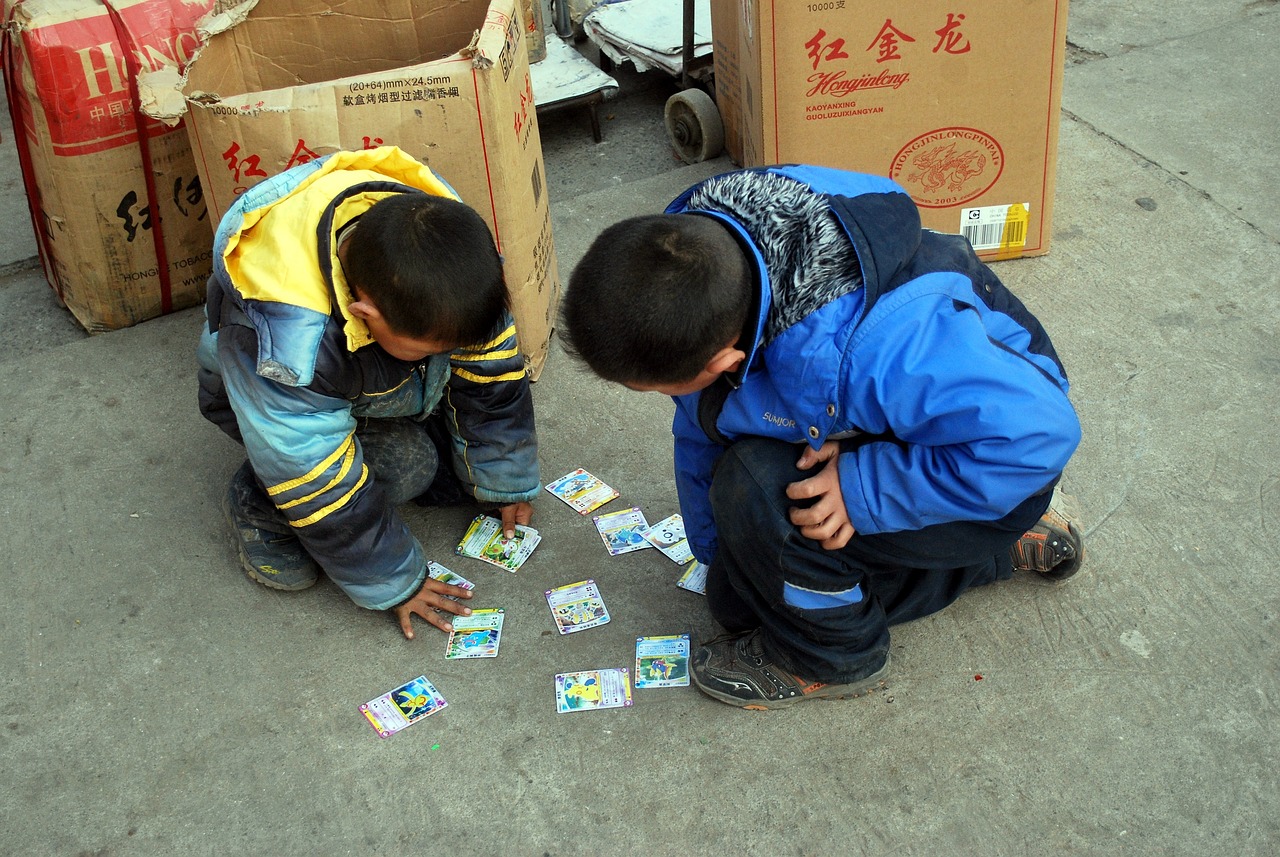How to Tackle Excessive Social Media Use in Kids?
In today's digital age, social media is as ubiquitous as the air we breathe. For kids, platforms like Instagram, TikTok, and Snapchat are not just apps; they are virtual playgrounds where friendships are forged, creativity is expressed, and sometimes, where anxiety creeps in. As parents, it can be daunting to navigate this new landscape. How do you ensure your child enjoys the benefits of social media without falling into the trap of excessive use? The key lies in understanding the impact of social media, recognizing the signs of overuse, and implementing effective strategies to promote healthier habits.
Social media can be a double-edged sword for children. On one hand, it offers a platform for self-expression and connection; on the other, it can wreak havoc on their mental health and self-esteem. Studies have shown that excessive use can lead to feelings of inadequacy, anxiety, and depression. It's essential to keep a close eye on how these platforms affect your child's emotional state. Are they more withdrawn after scrolling through their feeds? Do they often compare themselves to others? Understanding these dynamics is crucial for fostering a balanced approach to their digital lives.
So, how can you tell if your child is spending too much time online? Recognizing the indicators early can make a significant difference. Look for behavioral changes such as:
- Behavioral Changes: Mood swings, disrupted sleep patterns, or a drop in academic performance can all signal a problem.
- Social Withdrawal: If your child prefers online interactions over face-to-face ones, it might be time for a conversation.
- Increased Irritability: Notice if they become anxious or irritable when they can't access their devices.
- Physical Symptoms: Complaints of headaches, eye strain, or fatigue can also indicate excessive screen time.
Once you've identified the signs, the next step is to set healthy boundaries. Establishing clear guidelines around social media use can help your child learn self-regulation. Consider implementing:
- Screen Time Limits: Setting daily or weekly limits encourages a more balanced lifestyle.
- Designated Device-Free Times: Create times during meals or family activities when devices are off-limits to foster meaningful interactions.
One of the best ways to reduce excessive social media use is to promote alternative activities. Encourage your child to explore hobbies and interests outside of the digital realm. Whether it’s sports, arts, or music, engaging in these activities can help them develop new skills and friendships. For instance, participating in team sports not only promotes physical health but also provides opportunities for real-life socialization. Similarly, creative outlets like painting or writing can serve as powerful expressions of their feelings and thoughts.
Maintaining an open dialogue about social media can significantly benefit your child's relationship with technology. Discuss online safety, privacy, and the implications of sharing personal information. This empowers them to make informed decisions while navigating their digital lives. Additionally, create a safe space for them to express their feelings about social media. This way, you can address any issues that arise and provide support when necessary.
As a parent, you are a role model. Your relationship with technology will inevitably influence your child's perspective. Demonstrating a balanced approach to social media use can inspire them to do the same. Prioritize real-life interactions over digital ones and engage in offline activities together as a family. This not only reinforces the value of face-to-face connections but also encourages your child to appreciate time spent away from screens.
1. How much screen time is considered excessive for kids?
Experts recommend that children aged 2 to 5 should limit screen time to one hour per day, while older children should have consistent limits set by parents based on their individual needs.
2. What are some signs my child may be addicted to social media?
Signs include mood swings, irritability when not using social media, neglecting responsibilities, and a preference for online interactions over in-person communication.
3. How can I encourage my child to engage in offline activities?
Introduce them to a variety of hobbies, set aside family time for activities like hiking or board games, and limit screen time to encourage exploration of other interests.
4. Should I monitor my child's social media accounts?
Yes, monitoring can help you understand their online interactions and ensure their safety, but it’s also important to foster trust and open communication about their digital experiences.

The Impact of Social Media on Children
This article explores effective strategies for managing children's social media use, understanding its impact, and promoting healthier habits for balanced digital engagement.
In our digital age, social media has become a significant part of children's lives, but have you ever stopped to think about its impact? It's not just about sharing photos or chatting with friends; the effects can be profound and multifaceted. Research shows that social media can influence children's mental health, self-esteem, and even their social skills. For instance, children may compare themselves to their peers based on the curated images they see online, leading to feelings of inadequacy or anxiety. This comparison game can be detrimental, especially during formative years when self-identity is still being developed.
Moreover, while social media offers a platform for connection, it can paradoxically lead to feelings of isolation. Children may feel more comfortable interacting online, but this can come at the expense of real-life relationships. The irony is that while they are “socializing,” they might actually be missing out on the rich, nuanced interactions that occur face-to-face. According to studies, excessive use of social media can contribute to a range of emotional issues, including depression and anxiety. It's crucial for parents to understand these implications as they guide their children through the digital landscape.
To illustrate the impact further, let’s consider a few key areas affected by social media:
- Mental Health: Increased exposure to cyberbullying and negative comments can lead to anxiety and depression.
- Self-Esteem: Constantly comparing oneself to others can diminish self-worth.
- Social Skills: Over-reliance on online interactions can hinder the development of essential interpersonal skills.
As children navigate their online presence, it’s essential for parents to be vigilant and proactive. Understanding these impacts isn't just about limiting screen time; it's about fostering an environment where children can thrive both online and offline. Encouraging them to engage in meaningful activities outside of social media can help mitigate some of these negative effects. After all, a balanced approach to technology can lead to healthier, happier kids who are better equipped to handle the complexities of both the digital and real worlds.
Recognizing the indicators of excessive social media use in kids can help parents intervene early, ensuring that their children maintain a healthy relationship with technology.
Changes in mood, sleep patterns, and academic performance can signal that a child is spending too much time on social media, necessitating careful observation and appropriate responses.
When children retreat from face-to-face interactions or prefer online communication, it may indicate an unhealthy reliance on social media for socialization.
Frequent irritability or anxiety when not using social media can highlight a dependency that needs addressing to promote emotional well-being.
Physical signs such as headaches, eye strain, or fatigue can also arise from excessive screen time, emphasizing the need for moderation in social media use.
Establishing clear guidelines for social media use can help children learn self-regulation and understand the importance of balancing online and offline activities.
Implementing daily or weekly screen time limits encourages children to engage in a variety of activities beyond social media, fostering a healthier lifestyle.
Creating times during meals or family activities when devices are put away can strengthen family bonds and encourage meaningful interactions without digital distractions.
Promoting hobbies and interests outside of social media can help children develop new skills and friendships, reducing their reliance on online platforms for entertainment.
Engaging in sports or physical activities not only promotes health but also provides children with opportunities to socialize in person, enhancing their overall well-being.
Encouraging creative pursuits such as art, music, or writing can help children express themselves and explore their interests beyond the confines of social media.
Maintaining an open dialogue about social media use allows parents to understand their children's experiences and concerns, fostering trust and guidance in navigating the digital world.
Conversations about online safety, privacy, and the implications of sharing personal information can empower children to make informed decisions while using social media.
Creating a safe space for children to share their feelings about social media can help parents address any issues and provide support when needed.
Parents play a crucial role in shaping their children's relationship with technology; modeling healthy social media habits can inspire similar behaviors in kids.
By demonstrating a balanced approach to technology use, parents can teach their children the importance of moderation and prioritize real-life interactions over digital ones.
Participating in offline activities as a family reinforces the value of face-to-face connections, encouraging children to appreciate time spent away from screens.
Q: How can I tell if my child is using social media excessively?
A: Look for behavioral changes such as irritability, social withdrawal, or declining academic performance. Physical symptoms like headaches or fatigue can also be indicators.
Q: What are some effective ways to limit my child's social media usage?
A: Setting screen time limits, designating device-free times during meals, and encouraging alternative activities can help manage usage effectively.
Q: How can I encourage open communication about social media?
A: Create a safe space for discussions, ask open-ended questions, and share your own experiences to foster a trusting environment.

Identifying Signs of Excessive Use
Recognizing the indicators of excessive social media use in kids is essential for parents who want to ensure their children maintain a healthy relationship with technology. Just like a garden needs regular care to flourish, children require guidance and observation to navigate the digital landscape safely. By being vigilant, parents can intervene early and promote healthier habits. So, what should you look for?
One of the most noticeable signs of excessive use is behavioral changes. If your child suddenly becomes moody or irritable, it might be time to take a closer look at their social media habits. Frequent mood swings can be a red flag, indicating that their online interactions are affecting their emotional well-being. Additionally, changes in sleep patterns, such as difficulty falling asleep or waking up frequently during the night, can point to the influence of screen time on their overall health. Academic performance may also take a hit; if grades drop or homework is neglected, it’s a good idea to investigate the amount of time they’re spending online.
It’s not just about grades or mood; social withdrawal can also be a significant indicator of excessive social media use. If your child prefers chatting online over face-to-face interactions, it may suggest an unhealthy reliance on social media for socialization. This shift can lead to feelings of isolation, as they miss out on the rich, nuanced experiences that come with in-person communication. Similarly, increased irritability when they can’t access social media is another symptom of dependency. If your child becomes anxious or upset when they’re away from their devices, it’s crucial to address this behavior to promote their emotional well-being.
In addition to behavioral changes, physical symptoms can also arise from excessive screen time. Headaches, eye strain, and fatigue are common complaints among kids who spend too much time glued to their screens. These physical signs serve as a reminder that moderation is key. Just as too much sun can lead to sunburn, excessive screen time can lead to a range of health issues that can affect your child's daily life.
So, how can you keep track of these signs? Consider keeping a journal or a simple checklist to monitor your child's mood, sleep, and social interactions. This can help you identify patterns over time and intervene before things escalate. Remember, the goal is not to eliminate social media altogether but to teach your child how to use it responsibly.
By staying observant and proactive, parents can create a supportive environment where children learn to balance their online and offline lives. It’s all about fostering a healthy relationship with technology, ensuring that social media enhances their lives rather than detracts from it.
- What are some common signs of excessive social media use in children?
- How can I talk to my child about their social media use?
- What are some effective strategies for managing screen time?
- Is it okay for kids to use social media at all?
Common signs include behavioral changes, social withdrawal, increased irritability, and physical symptoms like headaches or fatigue.
Maintain an open dialogue by discussing their experiences online and encouraging them to share their feelings about social media.
Implement screen time limits, create device-free zones during family activities, and encourage alternative hobbies.
Yes, social media can be beneficial when used responsibly. The key is moderation and ensuring that it doesn’t interfere with their daily lives and responsibilities.

Behavioral Changes
When it comes to understanding how social media impacts our kids, one of the most significant areas to pay attention to is their . Often, these changes can serve as red flags, alerting parents that their child might be spending an unhealthy amount of time online. For instance, have you noticed your child becoming more withdrawn or irritable? These subtle shifts in behavior can be telling signs that social media is taking a toll on their emotional well-being.
Children who are glued to their screens may exhibit various that can affect their daily lives. Here are some key indicators to watch for:
- Changes in Mood: If your child seems more moody or easily frustrated than usual, it could be linked to their social media interactions. The constant barrage of notifications and online drama can lead to emotional ups and downs.
- Sleep Patterns: Are they having trouble falling asleep or staying asleep? Excessive screen time, especially before bed, can disrupt their natural sleep cycle, leading to fatigue and irritability.
- Academic Performance: A noticeable decline in grades or loss of interest in schoolwork can also be a sign of excessive social media use. When kids are preoccupied with their online lives, their academic responsibilities often take a back seat.
It's crucial to observe these changes carefully, as they can provide insight into your child's relationship with social media. For example, if they start to neglect their homework or show less enthusiasm for activities they once enjoyed, it might be time for a heart-to-heart conversation about their online habits.
Moreover, the impact of social media can extend beyond immediate behavioral changes. Over time, children may develop a dependency on their devices, feeling anxious or irritable when they can't check their notifications. This can create a vicious cycle where they turn to social media for comfort, further entrenching their reliance on it.
As parents, it’s essential to approach these behavioral changes with empathy and understanding. Instead of reacting with frustration or punishment, try to engage your child in an open discussion about their feelings and experiences online. Ask them questions like, “What do you enjoy most about social media?” or “Have you ever felt overwhelmed by it?” These conversations can help you gauge their perspective and offer guidance without making them feel judged.
In summary, being vigilant about behavioral changes in your child is key to understanding their social media use. By recognizing these signs early on, you can intervene and help them create a healthier relationship with technology, ensuring that their online interactions enhance rather than detract from their overall well-being.
- What are the signs that my child is using social media excessively?
Look for changes in mood, sleep disturbances, withdrawal from family activities, and declining academic performance. - How can I talk to my child about their social media use?
Engage them in a non-judgmental conversation, asking open-ended questions about their online experiences and feelings. - Should I set limits on my child's social media use?
Yes, establishing clear guidelines can help children learn self-regulation and balance their online and offline activities. - What alternative activities can I encourage my child to pursue?
Promote sports, arts, or other hobbies that foster creativity and physical activity, reducing their reliance on social media for entertainment.

Social Withdrawal
Social withdrawal in children is a significant concern, particularly in the context of excessive social media use. When kids start to prefer the glow of a screen over the warmth of real-life interactions, it can be a red flag indicating that something isn't quite right. Imagine a child who once thrived in group activities or family gatherings suddenly retreating into their room, opting for online chats instead of face-to-face conversations. This shift can have profound implications on their emotional and social development.
One of the most alarming aspects of social withdrawal is that it often goes unnoticed until it becomes a habit. Children might not even realize they are isolating themselves; they may simply feel more comfortable behind a screen. This can lead to a cycle where they miss out on essential social skills that are typically developed through in-person interactions. For instance, the nuances of body language, tone of voice, and immediate feedback from peers are all lost in digital communication.
Furthermore, social media can create a false sense of connection. While kids may have hundreds of online friends, these relationships often lack depth and authenticity. When they experience conflict or disappointment in their online interactions, they may not have the coping mechanisms to handle such situations, leading to increased feelings of loneliness and isolation. It's crucial for parents to recognize these signs early on and to encourage their children to engage in more real-world social activities.
To help combat social withdrawal, parents can take proactive steps, such as:
- Encouraging Group Activities: Whether it's joining a sports team, attending a club, or participating in community events, these activities can provide children with opportunities to interact with their peers in a structured environment.
- Setting Up Playdates: Organizing regular playdates with friends can help children reconnect with their peers and foster meaningful relationships outside of the digital realm.
- Modeling Social Engagement: Parents should demonstrate the importance of face-to-face interactions by engaging in social activities themselves, showing their children that real-life connections matter.
Ultimately, addressing social withdrawal is about creating a balanced approach to technology use. By fostering an environment where children feel comfortable engaging with others both online and offline, parents can help ensure their kids develop healthy social skills that will serve them well throughout their lives.
- What are the signs of social withdrawal in children? Look for changes in behavior, such as avoiding family activities, preferring online interactions, or showing disinterest in hobbies that once excited them.
- How can I encourage my child to engage socially? Promote participation in group activities, set up regular playdates, and model social behavior by engaging with others yourself.
- Is it normal for kids to spend time on social media? Yes, but moderation is key. It's important to balance online interactions with real-world socializing to ensure healthy development.

Increased Irritability
Have you ever noticed your child becoming increasingly irritable or anxious when they can't access their social media accounts? This behavior can often be a red flag indicating that they may be developing a dependency on these platforms. Just imagine a scenario where a child is engrossed in their favorite social media app, and suddenly, the Wi-Fi goes out. The immediate reaction might be a wave of frustration, tears, or even an outburst of anger. This response is not just about losing access to their digital world; it reflects a deeper emotional connection that has formed between them and their online interactions.
When kids start to exhibit signs of increased irritability, it is essential to take a step back and assess the situation. Ask yourself the following questions:
- How often does my child check their social media accounts?
- Do they seem more anxious or upset when they are offline?
- Are they neglecting responsibilities or activities they once enjoyed?
Understanding the root cause of this irritability can help parents intervene effectively. It’s crucial to recognize that social media can create an environment where children feel constant pressure to be available and responsive. The fear of missing out (FOMO) can lead to anxiety, making them feel as though they must stay connected at all times. This constant need to engage can hinder their emotional well-being and lead to unhealthy habits.
Moreover, increased irritability can manifest in various ways, such as:
- Frequent mood swings that seem disproportionate to the situation
- Difficulty concentrating on tasks or schoolwork
- Heightened sensitivity to criticism or feedback
As parents, it's essential to address these signs before they escalate. Initiating a conversation about their feelings and experiences with social media can provide valuable insights. By fostering an environment of open communication, you can help your child navigate their emotions and establish healthier relationships with technology. Remember, it's not just about limiting their social media use; it's about helping them understand their feelings and finding balance in their digital lives.
- What are the signs of social media addiction in children?
Common signs include increased irritability, withdrawal from family activities, and neglect of responsibilities. - How can I set boundaries for my child's social media use?
Establish clear screen time limits and create device-free zones during family time. - What activities can I encourage to reduce social media reliance?
Encourage participation in sports, arts, or other hobbies that promote face-to-face interactions. - How can I maintain open communication with my child about social media?
Regularly discuss their online experiences and feelings, ensuring they feel safe sharing their thoughts.

Physical Symptoms
When we think about the effects of excessive social media use on children, we often focus on emotional and behavioral changes. However, it's equally important to consider the that can arise from too much screen time. Children are not just scrolling through their feeds; they are engaging in activities that can lead to various health issues. For instance, prolonged exposure to screens can result in headaches, which may be caused by the strain on their eyes from staring at bright screens for extended periods. This phenomenon, often referred to as digital eye strain, can lead to discomfort and difficulty concentrating.
Another common physical symptom is fatigue. Kids might feel tired not just from lack of sleep, but also from the mental exhaustion that comes with constant engagement on social platforms. The overstimulation from notifications, messages, and the pressure to keep up with online trends can wear them out. Moreover, the blue light emitted from screens can interfere with their sleep patterns, leading to a vicious cycle of tiredness and increased screen time.
Additionally, children may experience neck and back pain due to poor posture while using their devices. Slouching on the couch or hunching over a phone can lead to musculoskeletal issues, which are becoming increasingly common among young users. It's essential for parents to recognize these signs early on and encourage their children to take regular breaks from screens, stretch, and maintain healthy posture while using technology.
Here’s a quick overview of some physical symptoms to watch out for:
- Headaches - Often due to eye strain or excessive screen time.
- Fatigue - Resulting from mental overstimulation and poor sleep quality.
- Neck and Back Pain - Caused by poor posture while using devices.
- Eye Strain - Symptoms include dryness, irritation, and blurred vision.
Recognizing these symptoms is the first step towards promoting a healthier lifestyle for your children. By encouraging regular breaks, outdoor activities, and balanced screen time, parents can help mitigate these physical issues and foster a more positive relationship with technology.
1. What are the signs of digital eye strain in children?
Children may complain of headaches, blurred vision, or dry eyes. If they frequently rub their eyes or squint while looking at screens, these could be signs of digital eye strain.
2. How can I help my child reduce screen time?
Setting clear boundaries for screen time, encouraging physical activities, and engaging in family activities can help reduce your child's screen time effectively.
3. What are some alternative activities to social media?
Encouraging hobbies such as sports, reading, and creative arts can provide fulfilling alternatives to social media engagement.
4. How can I talk to my child about online safety?
Open discussions about the importance of privacy, the risks of sharing personal information, and the potential consequences of online actions can empower children to navigate social media safely.

Setting Healthy Boundaries
In today's digital age, setting healthy boundaries around social media use is absolutely essential for children. Just like a garden needs a fence to protect it from unwanted intruders, our kids need guidelines to navigate the vast and often overwhelming world of social media. Establishing clear boundaries not only helps children learn self-regulation but also instills the importance of balancing online and offline activities. Think of it as giving them a roadmap to navigate their digital lives safely and responsibly.
One effective strategy is to implement screen time limits. By setting daily or weekly limits on social media usage, parents can encourage their children to explore a variety of activities beyond the digital realm. This approach fosters a healthier lifestyle and ensures that children engage in physical activities, hobbies, or even just quality family time. For instance, you might decide that weekdays are for homework and family dinners, while weekends can have a bit more flexibility. This way, children can learn to prioritize their time effectively.
Another important aspect is creating designated device-free times. Imagine sitting down for a family meal where everyone is glued to their screens—sounds familiar, right? By establishing specific times during meals or family activities when devices are put away, you can strengthen family bonds and encourage meaningful interactions without digital distractions. This not only enhances communication but also helps children appreciate the value of face-to-face conversations. You could even make it a fun family tradition, like a "no-phone Sunday," where everyone engages in board games or outdoor activities together.
It's also crucial to involve kids in these discussions. Ask them about their thoughts on social media use and how they feel about the boundaries being set. This not only empowers them but also makes them feel included in the decision-making process. After all, children are more likely to adhere to rules they had a hand in creating. So, grab a cup of hot chocolate, sit down with your kids, and have an open conversation about what they think would be fair and reasonable limits. This way, you’re not just imposing rules but fostering a collaborative environment.
In conclusion, setting healthy boundaries around social media is a vital step in ensuring that children develop a balanced relationship with technology. By implementing screen time limits and creating designated device-free times, parents can guide their kids towards healthier habits. Remember, it's not about restricting their freedom but rather about teaching them how to use technology responsibly. In the end, these boundaries can lead to a more fulfilling and enriching life for our children, both online and offline.
- What is a good daily screen time limit for kids? Experts recommend that children aged 2 to 5 should have no more than one hour of high-quality programming per day, while older kids should have consistent limits that allow for a healthy balance of activities.
- How can I encourage my child to engage in offline activities? Introduce them to various hobbies such as sports, arts and crafts, or even cooking. Make these activities fun and engaging to spark their interest.
- What should I do if my child resists setting boundaries? Have an open conversation about why these boundaries are important. Listen to their concerns and try to reach a compromise that satisfies both parties.

Screen Time Limits
Setting is like putting up a fence around a playground; it ensures that children can enjoy their digital space without wandering too far into potentially harmful territory. In today's fast-paced world, where social media is just a tap away, it’s essential for parents to establish clear boundaries that promote a balanced lifestyle. A well-defined limit on screen time encourages kids to explore various activities beyond their devices, fostering their creativity and social skills.
But how do you go about setting these limits? It’s not just about slapping a timer on their devices and calling it a day. Instead, it involves a thoughtful approach that takes into account your child's age, their daily activities, and the overall impact of screen time on their well-being. For instance, younger children may need stricter limits, while teenagers might benefit from more flexibility, as they learn to manage their own time.
To get started, consider implementing the following strategies:
- Daily Limits: Establish a maximum number of hours per day that your child can spend on social media. For example, you might decide that an hour after school is sufficient, allowing them to unwind while still engaging in other activities.
- Weekly Check-ins: Have regular conversations about their screen time usage. This not only helps in adjusting limits as needed but also encourages accountability in your child.
- Encourage Alternatives: Suggest engaging activities that can replace screen time, such as reading, sports, or family outings, making it easier for them to step away from their devices.
Additionally, using tools like parental control apps can help monitor and manage screen time more effectively. These apps can provide insights into how much time your child spends on various platforms, allowing you to identify patterns and adjust limits accordingly. However, it's crucial to approach this with transparency. Discuss with your child why these limits are in place, emphasizing that they are designed to benefit their health and development, not to punish them.
Remember, the goal is not to eliminate screen time entirely but to create a healthy balance. By setting reasonable limits, you are teaching your children valuable lessons about self-regulation and the importance of moderation. This approach not only protects their well-being but also empowers them to make better choices in the digital world.
- What is a good daily screen time limit for children? Experts recommend that children aged 2 to 5 should have no more than one hour of high-quality programming per day, while older children and teenagers should have consistent limits that take into account their activities and responsibilities.
- How can I encourage my child to engage in activities outside of screen time? Introduce them to hobbies they may enjoy, such as sports, arts, or music, and make family activities a priority to foster connection and engagement without screens.
- Are there any apps to help manage screen time? Yes, there are several parental control apps available that allow you to monitor and limit your child's screen time effectively, such as Qustodio, Net Nanny, and Screen Time.

Designated Device-Free Times
In today's fast-paced digital world, it can be all too easy for children to become glued to their screens, often at the expense of real-life interactions. Establishing is a powerful strategy for families looking to reclaim quality time together. Imagine a scenario where, during dinner, everyone puts their devices aside, allowing for genuine conversations and connections. This simple act not only encourages bonding but also helps children understand the value of being present in the moment.
Creating these device-free zones can be as straightforward as setting aside specific times each day or week when screens are turned off. For instance, you might decide that during family meals, game nights, or even weekend outings, all devices will be put away. This practice fosters an environment where family members can engage in meaningful conversations and share their daily experiences without the distraction of notifications or social media updates.
Moreover, these designated times can serve as a vital opportunity for parents to model healthy technology use. Children learn by example, and when they see their parents prioritizing real-life interactions over digital distractions, they are likely to adopt similar habits. It’s a chance to demonstrate that while technology has its place, it should not overshadow the importance of face-to-face connections.
To make this practice more effective, consider the following suggestions:
- Establish Clear Rules: Make sure the entire family is on board with the device-free times. Clearly communicate when these times will occur and why they are important.
- Offer Alternatives: Encourage engaging activities during these times, such as board games, cooking together, or going for a walk. This keeps everyone occupied and reinforces the idea that fun can be had without screens.
- Be Consistent: Consistency is key! Try to stick to the designated times as much as possible to create a routine that everyone can rely on.
Ultimately, introducing designated device-free times is not just about reducing screen time; it’s about enhancing family relationships and nurturing a healthier lifestyle. By carving out these moments, families can cultivate an atmosphere of connection and understanding, making it easier for children to balance their online and offline worlds.
Q: How do I convince my child to participate in device-free times?
A: Start by explaining the benefits of these times, emphasizing how they can enhance family bonding and create lasting memories. Involve your child in planning activities for these periods to make them feel included and excited.
Q: What if my child resists the idea of being device-free?
A: It's essential to be patient and understanding. You might consider starting with short device-free intervals and gradually increasing the duration as they become more accustomed to the idea.
Q: Can device-free times be beneficial for adults too?
A: Absolutely! Device-free times can help everyone in the family reconnect, reduce anxiety, and improve overall well-being. It’s a chance for all family members to engage with one another without the constant pull of technology.

Encouraging Alternative Activities
In today's fast-paced digital world, it's easy for children to become glued to their screens, scrolling through social media feeds and losing track of time. However, as parents, we have the power to steer our kids towards a more balanced lifestyle by encouraging alternative activities that ignite their passions and foster personal growth. Imagine replacing those endless hours of screen time with adventures that stimulate their minds and bodies! So, how can we inspire our children to delve into hobbies and interests beyond the digital realm?
First and foremost, it's essential to introduce them to a variety of activities that spark their interest. Whether it's sports, arts, music, or even volunteering, the options are limitless. For instance, engaging in sports and physical activities not only promotes health but also provides children with opportunities to socialize in person, enhancing their overall well-being. Picture your child running around in a park, laughing with friends, and developing teamwork skills instead of being cooped up indoors. Isn’t that a sight worth encouraging?
Moreover, creative outlets can be a fantastic way for kids to express themselves. Activities such as art, music, or writing allow children to explore their interests and showcase their talents. Imagine your child painting a vibrant canvas or strumming a guitar, pouring their emotions into their creations. These activities can help them build confidence and a sense of achievement that scrolling through likes on social media simply can’t provide.
To make this transition smoother, consider setting up a schedule that includes designated times for these alternative activities. For example, you might allocate a couple of evenings each week for family game nights, art projects, or outdoor excursions. This not only helps instill a routine but also reinforces the idea that these activities are just as important as their online interactions. Here’s a simple table to illustrate a potential weekly schedule:
| Day | Activity | Time |
|---|---|---|
| Monday | Family Game Night | 6 PM - 8 PM |
| Wednesday | Art & Craft Session | 5 PM - 7 PM |
| Friday | Outdoor Sports | 4 PM - 6 PM |
| Saturday | Music Jam Session | 3 PM - 5 PM |
Additionally, it’s crucial to involve your children in the decision-making process. Ask them what activities they might be interested in pursuing. This not only gives them a sense of ownership over their choices but also makes them more likely to engage wholeheartedly. Think of it as planting seeds in a garden; when children choose their own flowers to nurture, they’ll be more invested in watching them bloom.
In conclusion, encouraging alternative activities is about creating a balance that enriches our children's lives. By providing them with opportunities to explore their interests, we help them develop new skills, foster friendships, and cultivate a sense of purpose that can often be overshadowed by the allure of social media. So, let’s put down those devices and embark on this exciting journey together!
- What if my child resists participating in alternative activities? It's normal for kids to resist change. Start small and gradually introduce new activities, making sure to keep it fun and pressure-free.
- How can I make alternative activities more appealing? Involve your child in the planning process and allow them to choose activities that interest them. You can also join them to make it a family affair!
- What are some easy activities to start with? Consider simple options like biking, drawing, or playing board games. These can be low-pressure ways to get started.

Sports and Physical Activities
Engaging in sports and physical activities is not just about keeping fit; it’s a gateway to a world of benefits that can significantly enhance a child's life. Imagine a child running freely on a field, laughter echoing as they kick a soccer ball or shoot hoops with friends. These moments are not just fun; they are essential for physical health, social skills, and emotional well-being. By participating in sports, children learn important life skills such as teamwork, discipline, and resilience. They discover the thrill of competition and the joy of personal achievement, which can boost their self-esteem immensely.
Moreover, sports provide a natural outlet for energy and stress. In our digital age, where children often find themselves glued to screens, the importance of physical activity cannot be overstated. Regular participation in sports helps combat the risks associated with a sedentary lifestyle, such as obesity and related health issues. It’s like giving their bodies a much-needed tune-up, ensuring they are not only healthy but also active and energetic.
Social interactions are another significant advantage of engaging in sports. When children participate in team activities, they are not just playing; they are learning how to communicate, collaborate, and build friendships. These interactions can lead to lasting bonds and a sense of belonging, which is crucial for their emotional development. Think about it: a child who plays on a team has a built-in support system, a group of peers who share similar interests and challenges. This can be a powerful antidote to feelings of isolation that excessive social media use can foster.
To illustrate the benefits further, let’s take a look at a simple table that summarizes the advantages of sports and physical activities:
| Benefits | Description |
|---|---|
| Physical Health | Helps maintain a healthy weight, improves cardiovascular health, and strengthens muscles and bones. |
| Social Skills | Encourages teamwork, communication, and the ability to work with others towards a common goal. |
| Emotional Well-being | Reduces stress and anxiety, boosts self-esteem, and promotes a sense of achievement. |
| Life Skills | Teaches discipline, time management, and the importance of setting and achieving goals. |
Incorporating sports into a child’s routine doesn’t have to be a daunting task. Parents can start by exploring local sports clubs or community programs that offer a variety of options. Whether it's soccer, basketball, swimming, or even dance, the key is to find something that resonates with the child’s interests. The excitement of trying something new can ignite a passion for physical activity that lasts a lifetime.
Ultimately, the goal is to create a balanced lifestyle where physical activity is a regular part of the day. By encouraging children to step away from screens and embrace the outdoors, we are not only promoting their physical health but also enriching their lives with experiences that foster growth, friendships, and unforgettable memories.
Q: How much physical activity should children engage in each week?
A: The CDC recommends that children and adolescents aged 6 to 17 years should get at least 1 hour of physical activity each day. This can include a mix of aerobic, muscle-strengthening, and bone-strengthening activities.
Q: What if my child is not interested in traditional sports?
A: That's perfectly okay! Encourage them to explore a variety of activities. Dance, martial arts, or even hiking can be excellent alternatives that keep them active and engaged.
Q: How do I motivate my child to participate in sports?
A: Start by joining them in activities you enjoy, making it a family affair. Celebrate their achievements, no matter how small, and focus on the fun aspects rather than competition.

Creative Outlets
In today's digital age, where screens dominate our children's attention, it's essential to encourage that allow them to express themselves beyond the confines of social media. Engaging in creative activities not only nurtures their imagination but also provides a healthy distraction from the constant pull of online platforms. Think of it as giving them a palette of colors to paint their world, rather than letting them be mere spectators in a digital slideshow.
Creative pursuits can take many forms, from art and music to writing and performing. Each of these activities opens doors to new experiences and skills, helping children discover their passions and talents. For instance, when a child picks up a paintbrush, they aren't just creating art; they're learning to communicate their feelings, thoughts, and ideas visually. This process can be incredibly therapeutic and empowering, allowing them to forge a deeper connection with their emotions.
Moreover, engaging in creative activities can also foster social connections. When children participate in group classes or workshops—be it a painting class, a music band, or a writing club—they meet peers who share similar interests. This interaction can lead to meaningful friendships and a sense of belonging that online interactions often lack. It's a beautiful way to blend creativity with socialization, helping them develop both their artistic skills and their social competencies.
Here are some creative outlets to consider:
- Art: Drawing, painting, or sculpting can be great ways for kids to express their thoughts and feelings.
- Music: Learning to play an instrument or joining a choir can enhance their listening skills and boost their confidence.
- Writing: Encouraging them to write stories, poems, or even keep a journal can improve their literacy skills and provide an emotional outlet.
- Drama: Participating in theater can help children develop public speaking skills and enhance their creativity.
It's important to remember that the goal is not to pressure children into becoming the next Picasso or Mozart but to provide them with opportunities to explore and enjoy their creativity. By fostering an environment where creative expression is valued, we can help children build a well-rounded skill set that serves them far beyond their formative years.
Q: How can I encourage my child to engage in creative activities?
A: Start by introducing them to various creative outlets and letting them choose what interests them. Provide the necessary materials and, if possible, enroll them in classes or workshops to enhance their skills.
Q: What if my child is resistant to trying new creative activities?
A: It's essential to be patient. Encourage them gently and participate with them in these activities. Sometimes, seeing a parent engaged can spark their interest.
Q: How do creative outlets benefit my child's mental health?
A: Creative activities can act as a stress reliever, helping children process their emotions and thoughts. They provide a constructive way to cope with anxiety and boost self-esteem through accomplishment.
Q: Can creative activities help improve my child's social skills?
A: Absolutely! Group activities, like art classes or music bands, foster collaboration and communication, allowing children to build friendships and learn teamwork.

Open Communication with Kids
Maintaining an open dialogue about social media use is essential for fostering a healthy relationship between children and technology. When parents create an environment where kids feel comfortable discussing their online experiences, it not only helps in understanding their perspectives but also builds a foundation of trust. Have you ever wondered what your child really thinks about their social media interactions? Engaging them in conversation can reveal insights that might surprise you!
One effective approach is to initiate discussions about their online activities without sounding accusatory. Instead of asking, "Why are you always on your phone?" consider phrasing it as, "What do you enjoy most about using social media?" This subtle shift in language can encourage kids to share their thoughts and feelings openly. It’s crucial to listen actively, showing genuine interest in their responses. This way, children feel valued and understood, making them more likely to share their concerns and experiences.
Moreover, discussing topics such as online safety and privacy is vital. Kids need to know the potential risks associated with social media, including the importance of keeping personal information private. By educating them about these issues, you empower them to make informed decisions. For instance, you might explain the concept of digital footprints, illustrating how their online actions can have lasting consequences. This conversation can be framed as a collaborative effort to navigate the digital world together, rather than a lecture.
Here are some key points to cover during these discussions:
- Understanding Online Safety: Talk about the importance of not sharing personal information, such as addresses or phone numbers, with strangers.
- Recognizing Cyberbullying: Encourage children to speak up if they encounter bullying online and reassure them that they can always come to you for support.
- Setting Expectations: Discuss what constitutes appropriate online behavior and the importance of treating others with respect, just as they would in person.
Additionally, encouraging honest conversations about their feelings towards social media can be enlightening. Ask open-ended questions like, "How does social media make you feel?" or "Have you ever felt pressured to post something?" These questions can help identify any negative emotions they might associate with their online presence. Remember, kids often face peer pressure and may feel compelled to portray a perfect life online. By discussing these pressures, you can help them develop resilience and a more balanced view of social media.
Finally, creating a safe space for these discussions is crucial. Let your kids know that they can talk to you about anything without fear of judgment. This openness will encourage them to approach you with their concerns, whether they are about social media or other aspects of their lives. After all, building a strong line of communication is not just about talking; it’s equally about listening and responding with empathy.
| Question | Answer |
|---|---|
| How can I start a conversation about social media with my child? | Begin by asking open-ended questions about their online experiences, showing genuine interest in their responses. |
| What are some signs that my child may be struggling with social media use? | Look for changes in mood, increased irritability, social withdrawal, or physical symptoms like headaches. |
| How do I ensure my child understands online safety? | Discuss the importance of privacy, recognizing cyberbullying, and setting expectations for appropriate online behavior. |
| What should I do if my child feels pressured to post on social media? | Encourage open dialogue about their feelings and reassure them that it’s okay to take a break from posting. |

Discussing Online Safety
In today's digital age, discussing online safety with kids is more important than ever. As children navigate the vast landscape of social media, they encounter various risks that can impact their well-being. Parents need to have open conversations about these dangers, helping their children understand how to protect themselves online. But what exactly should these discussions entail?
First and foremost, it's crucial to talk about the importance of privacy settings. Kids often don't realize that their personal information can be easily accessed by others if they don't take the right precautions. Encourage them to regularly review their privacy settings on all social media platforms and to only share information with trusted friends. You might say, "Think of your online profile as your home. You wouldn't invite strangers in, right? So, why share personal details online?"
Another key aspect is the concept of digital footprints. Every post, photo, or comment leaves a trace that can be permanent. Help your children understand that what they share today could impact their future. Discuss scenarios where a college or employer might look up their online presence. You could frame it like this: "Imagine if someone judged you based on a silly picture you posted years ago. Wouldn't you want to control that?"
Additionally, it's essential to educate them about cyberbullying. Explain what cyberbullying is and how to recognize it, whether they are victims or bystanders. Encourage them to speak up if they encounter bullying and assure them that they can always come to you for support. You might want to share some statistics to emphasize the seriousness of the issue:
| Statistic | Percentage |
|---|---|
| Children who experience cyberbullying | 34% |
| Kids who don’t report bullying incidents | 60% |
Lastly, discussing the importance of critical thinking is vital. Teach your kids to question the content they see online. Encourage them to ask, "Is this true?" or "Who created this?" This not only helps them become more discerning consumers of information but also empowers them to make safer choices online.
In conclusion, having these discussions about online safety can significantly impact your child's ability to navigate the digital world responsibly. Remember, it’s not just about setting rules; it’s about fostering an environment where your children feel comfortable discussing their online experiences with you. This open line of communication can be a powerful tool in ensuring their safety and well-being in an increasingly digital landscape.
- What age should I start talking to my kids about online safety?
It's best to start these conversations as early as they begin using technology, adapting the discussions to their age and understanding. - How can I monitor my child's social media use without invading their privacy?
Encourage open communication and set guidelines together. Use parental controls if necessary, but always explain why these measures are in place. - What should I do if my child encounters cyberbullying?
Encourage them to talk to you about it, document the incidents, and report them to the platform. Offer emotional support and reassure them that it’s not their fault.

Encouraging Honest Conversations
When it comes to navigating the complex world of social media, one of the most effective tools parents have is the ability to foster open and honest conversations with their children. Imagine a bridge built on trust and understanding; that's what these conversations can create. It’s essential to create an environment where kids feel comfortable sharing their thoughts and feelings about their online experiences. After all, social media can be a double-edged sword—offering connection and creativity on one side, while also presenting risks like cyberbullying and unrealistic comparisons on the other.
To encourage these conversations, parents can start by asking open-ended questions that invite children to express themselves. Instead of simply asking, “Did you have a good day on social media?” try something like, “What’s the most interesting thing you saw online today?” This not only demonstrates your interest but also opens the door for a deeper discussion. Children are more likely to engage when they feel their opinions are valued and respected.
Moreover, it’s important to validate their feelings. If your child shares a negative experience, such as feeling left out or upset by something they saw, acknowledge their emotions. You might say, “I can see how that would make you feel sad. It’s tough to see things like that.” This validation can help children feel understood and less isolated in their experiences.
Another key aspect of encouraging honest conversations is to create a safe space for dialogue. Let your child know that they can talk to you about anything without fear of judgment or immediate consequences. This doesn’t mean that all behavior should go unchecked; rather, it’s about establishing a foundation of trust where your child feels secure enough to bring up concerns or mistakes. For instance, if they come across something inappropriate, they should feel comfortable discussing it with you rather than hiding it out of fear.
Additionally, consider incorporating regular family discussions about social media. You could set aside time each week to talk about online experiences, sharing both positive and negative stories. This not only normalizes the conversation but also provides an opportunity for parents to share their own experiences and lessons learned, reinforcing the idea that everyone navigates the digital world together. You might even create a family agreement regarding social media use, outlining shared values and expectations, which can serve as a guide for everyone involved.
Ultimately, the goal is to empower children to make informed decisions about their social media use. By engaging in honest conversations, parents can help their kids develop critical thinking skills about the content they consume and share. This not only prepares them for the challenges of social media but also strengthens their ability to communicate openly about their feelings and experiences, fostering a healthy relationship with technology.
- How can I start a conversation about social media with my child? Begin by asking open-ended questions about their experiences online and show genuine interest in their responses.
- What if my child doesn’t want to talk about social media? Try to create a relaxed environment and give them time. Sometimes, they may open up when they feel less pressured.
- How can I ensure my child feels safe discussing their online experiences? Reassure them that they can talk to you without fear of punishment or judgment. Validation of their feelings is key.
- Should I monitor my child’s social media use? While it’s important to be aware of their activities, fostering trust through open communication is equally crucial.

Modeling Healthy Behavior
As parents, we often find ourselves in a unique position of influence when it comes to our children's habits and behaviors. The way we interact with technology, especially social media, sets a powerful example for our kids. If we want them to develop a healthy relationship with social media, it’s essential that we demonstrate this balance in our own lives. Think of it as being the compass that guides them through the vast digital landscape. When children see their parents engaging with technology mindfully, they are more likely to adopt similar practices.
One effective way to model healthy behavior is by establishing screen time boundaries for ourselves. For example, if we set a rule to avoid screens during family meals, it signals to our children that these moments are valuable and should be cherished. This not only encourages them to follow suit but also fosters stronger family connections. Imagine a dinner table where everyone is engaged in conversation rather than scrolling through their phones—this is the kind of environment that nurtures meaningful relationships.
Moreover, engaging in offline activities as a family can significantly reinforce the importance of face-to-face interactions. Whether it's playing board games, going for a hike, or simply enjoying a movie night without distractions, these experiences create lasting memories and teach children to appreciate time spent away from screens. When they see their parents prioritizing these moments, it instills a sense of balance in their own lives.
To further emphasize this point, consider the following table that outlines some practical ways parents can model healthy social media behavior:
| Activity | Description | Benefits |
|---|---|---|
| Device-Free Meals | No screens during meal times. | Encourages conversation and connection. |
| Family Outings | Plan regular outings without devices. | Strengthens family bonds and creates memories. |
| Shared Hobbies | Engage in hobbies together, like painting or gardening. | Fosters teamwork and creativity. |
In addition to these activities, it’s also vital to demonstrate how to use social media responsibly. This means discussing the importance of privacy settings, being cautious about what to share, and recognizing the impact of online interactions on mental health. When parents openly share their own experiences and challenges with social media, it creates a safe space for children to express their concerns and ask questions. It’s like having a roadmap for navigating the digital world—one that is filled with both opportunities and potential pitfalls.
Ultimately, by embodying the principles of moderation and mindfulness in our own social media use, we pave the way for our children to do the same. Remember, children are like sponges; they absorb everything around them. So, let's give them something positive to soak up!
- What are some signs that my child is using social media excessively?
Look for changes in mood, sleep patterns, and social interactions. If they seem more withdrawn or irritable, it may be time to check in with them. - How can I encourage my child to engage in offline activities?
Introduce them to new hobbies or sports and participate together. Make these activities fun and rewarding! - What if my child resists setting boundaries on social media use?
Have open conversations about why these boundaries are important and involve them in the decision-making process. This can help them feel more in control.

Demonstrating Balance
In the fast-paced digital age, where screens dominate our daily interactions, it's essential for parents to demonstrate balance in their own technology use. Kids are like sponges, absorbing everything around them, including how their parents engage with social media and technology. If a child sees their parent glued to a screen during family meals or activities, they may internalize that as acceptable behavior. Instead, parents can actively model a balanced approach that prioritizes real-world connections over digital distractions.
One effective way to showcase this balance is by establishing technology-free zones at home. These can be areas like the dining room or living room, where the family can engage in conversations, play games, or simply enjoy each other's company without the interference of devices. By setting these boundaries, parents not only encourage their children to put down their phones but also create an environment that fosters meaningful interactions. This practice can lead to deeper conversations and stronger family bonds.
Moreover, parents should engage in offline activities together as a family. This could be anything from going for a hike, playing board games, or even cooking a meal together. These experiences not only provide a break from screens but also help children develop social skills and learn the importance of teamwork. When children see their parents prioritizing these moments, they are more likely to understand the value of being present and engaged in the moment.
Another important aspect of demonstrating balance is sharing time management strategies with children. Parents can discuss how they allocate time for work, leisure, and family activities. This can include using a
| Activity | Time Allocated |
|---|---|
| Work/School | 8 hours |
| Family Time | 3 hours |
| Hobbies/Sports | 2 hours |
| Screen Time | 1 hour |
| Rest/Sleep | 8 hours |
This table not only helps children visualize how to allocate their time effectively but also opens the door for discussions about prioritizing activities that contribute positively to their well-being. By integrating these practices into daily life, parents can significantly influence their children's perception of technology and encourage them to develop a healthy, sustainable relationship with social media.
Ultimately, demonstrating balance is about more than just time management; it's about instilling values that prioritize well-being and meaningful connections. By being proactive in their own habits and encouraging their children to do the same, parents can create a harmonious environment where technology serves as a tool for connection rather than a barrier to it.
- How can I tell if my child is spending too much time on social media?
Look for signs such as changes in mood, sleep disturbances, and a decline in academic performance. - What are some effective ways to set screen time limits?
Implement daily or weekly limits, and use apps or built-in device features to monitor usage. - How can I encourage my child to engage in offline activities?
Introduce them to hobbies, sports, or family outings that don’t involve screens. - What should I do if my child is resistant to limiting their social media use?
Have open conversations about their feelings and explain the importance of balance and mental health.

Engaging Together Offline
In our fast-paced, technology-driven world, it's all too easy for families to get caught up in their screens, often forgetting the joy of spending quality time together. Engaging in offline activities as a family not only strengthens bonds but also creates lasting memories that digital interactions simply can't replicate. Imagine the laughter echoing through your home as everyone participates in a board game or the warmth of a shared meal without the distraction of notifications buzzing in the background. These moments are vital for nurturing relationships and fostering a sense of belonging.
So, what are some fun offline activities that families can enjoy together? Here are a few suggestions:
- Outdoor Adventures: Whether it’s hiking, biking, or simply taking a stroll in the park, outdoor activities encourage physical health and provide a refreshing break from screens.
- Cooking Together: Preparing meals as a family can be both educational and entertaining. Kids can learn about nutrition while having fun experimenting with different ingredients.
- Arts and Crafts: Get creative! Engaging in arts and crafts allows everyone to express themselves and work together on projects, fostering teamwork and creativity.
- Family Movie Nights: Turn off the devices and enjoy a movie night with popcorn and cozy blankets. Discussing the film afterward can spark interesting conversations.
- Reading Together: Choose a book that everyone can enjoy and take turns reading aloud. This not only promotes literacy but also creates a shared experience.
By incorporating these activities into your family's routine, you can create a balanced lifestyle that values real-life connections over digital distractions. The key is to prioritize these moments, making them a non-negotiable part of your family's schedule. For instance, designating a specific night each week for family activities can help everyone look forward to this time together, reinforcing the importance of offline engagement.
Moreover, when families engage in offline activities, they model healthy behavior for their children. Kids learn to appreciate the world around them, understand the value of face-to-face interactions, and develop skills that are essential for their social development. It's all about creating an environment where technology serves as a tool rather than a crutch.
In conclusion, the importance of engaging together offline cannot be overstated. As parents, taking the initiative to unplug and spend quality time with your children is one of the best gifts you can give them. Not only does it enhance family bonds, but it also fosters a sense of security and belonging that is crucial for their emotional well-being. So, let’s put down our devices and pick up some board games or head out for an adventure; the connections we build today will shape the memories we cherish tomorrow.
Q1: How can I encourage my child to participate in offline activities?
A1: Start by leading by example. Show enthusiasm for offline activities and invite your child to join. Make it a fun challenge or reward them with a special treat for participating.
Q2: What if my child prefers screen time over offline activities?
A2: Gradually introduce offline activities that align with their interests. For example, if they love video games, suggest a board game with a similar theme. Also, limit screen time to create space for offline engagement.
Q3: How do I balance screen time and offline activities?
A3: Establish clear rules and routines. For instance, designate specific times for screen use and ensure that family activities are scheduled regularly to create a balanced lifestyle.
Q4: What are some benefits of engaging in offline activities?
A4: Engaging in offline activities promotes better communication, strengthens family bonds, encourages physical fitness, and helps children develop important social skills.
Frequently Asked Questions
- What are the signs of excessive social media use in children?
Signs of excessive social media use can include behavioral changes such as mood swings, sleep disturbances, and declining academic performance. Additionally, social withdrawal and increased irritability when not online are red flags that parents should watch for.
- How can I set healthy boundaries for my child's social media use?
Establishing healthy boundaries can be achieved by implementing screen time limits and designating device-free times during meals or family activities. This encourages children to engage in various offline activities, promoting a balanced lifestyle.
- What alternative activities can I encourage for my child?
Encouraging sports and physical activities is a great way to promote health and socialization. Additionally, creative outlets like art, music, or writing can help children explore their interests outside of social media, fostering new skills and friendships.
- How important is open communication about social media?
Open communication is crucial as it allows parents to understand their children's experiences and concerns. Discussing online safety and encouraging honest conversations creates a supportive environment for children to share their feelings about social media.
- What role do parents play in modeling social media use?
Parents play a significant role in shaping their children's relationship with technology. By demonstrating a balanced approach to social media and engaging in offline activities together, parents can inspire similar habits in their kids, emphasizing the importance of real-life interactions.



















